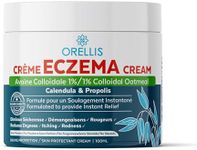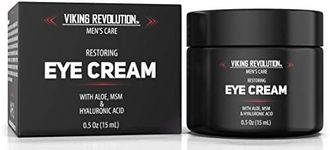Buying Guide for the Best Eczema Treatment For Eyelids
Choosing the right eczema treatment for your eyelids is important because the skin in this area is very thin and sensitive. The goal is to find a product that soothes irritation, reduces inflammation, and helps restore the skin barrier without causing further irritation or side effects. When selecting a treatment, it's essential to consider the ingredients, formulation, and how the product is applied. Always consult with a healthcare professional before starting any new treatment, especially for delicate areas like the eyelids.Active IngredientsActive ingredients are the components in a treatment that actually work to relieve eczema symptoms. For eyelid eczema, common active ingredients include mild corticosteroids, calcineurin inhibitors, or soothing agents like colloidal oatmeal. This spec is important because the effectiveness and safety of the treatment depend on what it contains. Mild corticosteroids are often used for short-term relief but should be used with caution on the eyelids due to the risk of thinning the skin. Calcineurin inhibitors are non-steroidal and can be safer for long-term use on sensitive areas. If you have mild symptoms or want to avoid steroids, look for products with soothing, non-medicated ingredients. Your choice should be guided by the severity of your eczema and any previous reactions to medications.
Formulation TypeFormulation type refers to the physical form of the treatment, such as cream, ointment, gel, or lotion. This matters because different formulations have different levels of moisture and absorption. Ointments are thicker and provide more moisture, making them good for very dry or cracked skin, but they can feel greasy. Creams are lighter and absorb more quickly, which can be more comfortable for daytime use. Gels and lotions are usually lighter still and may be better for mild cases or for people who dislike heavy products. If your eyelids are very dry, an ointment may be best, while a cream or lotion might be preferable for less severe dryness or for use under makeup.
Fragrance and AdditivesFragrance and additives refer to extra ingredients added for scent, texture, or preservation. These can be problematic for sensitive skin, especially on the eyelids, as they may cause irritation or allergic reactions. It's important to choose products labeled as fragrance-free and hypoallergenic to minimize the risk of further irritation. If you have a history of allergies or sensitive skin, always check the ingredient list and avoid products with unnecessary additives. Your need for a gentle, non-irritating product should guide you toward the simplest formulas.
Application MethodApplication method describes how the treatment is applied to the skin, such as with a tube, pump, or applicator. This is important because the eyelid area is small and delicate, so precise and gentle application is necessary. Tubes and pumps can help you dispense a small, controlled amount, reducing the risk of over-application. Some products come with applicators designed for sensitive areas. If you have difficulty applying creams or ointments, look for packaging that makes it easy to use just the right amount. Your comfort and ability to apply the product gently should guide your choice.
Suitability for Sensitive SkinSuitability for sensitive skin means the product has been tested and shown to be safe for use on delicate or easily irritated skin. This is especially important for eyelid eczema, as the skin here is more prone to reactions. Look for products that are dermatologically tested, labeled as safe for sensitive skin, and recommended for use around the eyes. If you have a history of skin reactions, this should be a top priority in your selection process.








